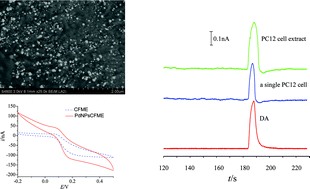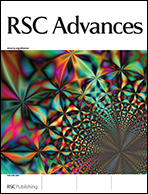Determination of dopamine in rat less differentiated pheochromocytoma cells by capillary electrophoresis with a palladium nanoparticles microdisk electrode
Abstract
A simple method was described for the direct detection of dopamine (DA) in single rat pheochromocytoma cells (PC12 cells) by capillary electrophoresis with a palladium nanoparticles modified carbon fiber microdisk electrode (PdNPsCFME). The Pd nanoparticles could be electrodeposited on the surface of the carbon fiber microdisk electrode (CFME) with a simple pretreatment procedure. The PdNPsCFME provided an enhanced effective electrode surface and high catalytic activity toward dopamine compared to traditional CFME. Under optimized detection conditions, dopamine responded linearly from the range of 0.2 μM to 2 μM and 2 μM to 0.1 mM with correlation coefficients of 0.9979 and 0.9990. The concentration detection limit was 0.1 μM (S/N = 3). The relative standard deviations of the migration time and peak current were 1.4% and 3.5%, respectively. This method had been successfully applied to determine DA in single PC12 cells and the amount of DA in ten PC12 cells ranged from 1.2 to 6.3 fmol. The above results demonstrated that CE coupled with PdNPsCFME is convenient, sensitive, and will become an attractive alternative method for single-cell analysis.


 Please wait while we load your content...
Please wait while we load your content...